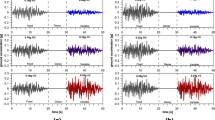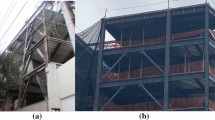Abstract
Earthquake-induced structural damage, characterised by the exceedance of different damage states during ground shaking, is typically quantified using fragility curves generated through non-linear dynamic analyses often requiring a large computational effort. This level of effort has led to the necessity of simplified methods and approximate analysis tools. In this regard, SPO2IDA has emerged as a convenient tool for the assessment of structures. It relates a structure’s backbone characteristics to a set of incremental dynamic analysis (IDA) curves using static pushover analysis (SPO) results and a library of empirical fitting coefficients for the different branches of the idealised SPO backbone. It permits the quantification of structural performance up to structural collapse as a function of seismic intensity in a simple and efficient manner. It has been developed mainly for ductile structures that can be sufficiently represented via a SPO backbone with a certain ductile post-yield hardening followed by a post-peak degradation. This behaviour is quite representative of ductile RC and steel moment-resisting frames and has resulted in the tool being widely adopted. However, the same may not be observed when dealing with reinforced concrete (RC) frames with masonry infill, a structural typology that still requires significant addressing in the earthquake engineering field. The present study describes an extension to this methodology for structural typologies with a more particular backbone behaviour, typical of RC frames with masonry infill panels, since differences in backbone behaviour compared to typical structures render the extension of the original tool inappropriate and at times unconservative. Extensive analyses were conducted to investigate the behaviour and trends when pushing infilled RC frames up to complete structural collapse. A new library of empirical coefficients was then fitted and proposed by considering a large database of representative backbones to result in an extended SPO2IDA proposal for infilled RC frames. It is then shown how these coefficients provide a much-improved matching, when compared to the original tool for this specific case, both in terms of the produced IDA traces and also the drift-based mean annual rates of exceedance.



















Adapted from O’Reilly et al. (2019)


Similar content being viewed by others
References
Baker JW (2015) Efficient analytical fragility function fitting using dynamic structural analysis. Earthq Spectra 31(1):579–599. https://doi.org/10.1193/021113EQS025M
Baltzopoulos G, Baraschino R, Iervolino I, Vamvatsikos D (2017) SPO2FRAG: software for seismic fragility assessment based on static pushover. Bull Earthq Eng. https://doi.org/10.1007/s10518-017-0145-3
CNR (2014) Istruzioni per la Valutazione Affidabilistica della Sicurezza Sismica di Edifici Esistenti. CNR—Commissione Di Studio per La Predisposizione e l’analisi Di Norme Tecniche Relative Alle Costruzioni
Cornell CA, Krawinkler H (2000) Progress and challenges in seismic performance assessment. PEER Center News 3(2):1–2
Crisafulli FJ, Carr AJ (2007) Proposed macro-model for the analysis of infilled frame structures. Bull N Z Soc Earthq Eng 40(2):69–77
D’Ayala D, Meslem A, Vamvatsikos D, Porter K, Rossetto T, Crowley H et al (2015) Guidelines for analytical vulnerability assessment—low/mid-rise. GEM Tech Rep 08:162. https://doi.org/10.13117/GEM.VULN-MOD.TR2014.12
Dolšek M, Fajfar P (2004) Inelastic spectra for infilled reinforced concrete frames. Earthq Eng Struct Dyn 33(15):1395–1416. https://doi.org/10.1002/eqe.410
Dolšek M, Fajfar P (2005) Simplified non-linear seismic analysis of infilled reinforced concrete frames. Earthq Eng Struct Dyn 34(1):49–66. https://doi.org/10.1002/eqe.411
Fajfar P, Dolšek M (2012) A practice-oriented estimation of the failure probability of building structures. Earthq Eng Struct Dyn 41(3):531–547. https://doi.org/10.1002/eqe.1143
FEMA (2000) FEMA 356: pretandardand commentary for the seismic rehabilitation of buildings. FEMA, Washington, DC
FEMA (2005) FEMA 440: improvement of nonlinear static seismic analysis procedures. FEMA, Washington, DC
FEMA (2009) FEMA P695: quantification of building seismic performance factors. FEMA, Washington, DC
FEMA (2012) FEMA P-58-1: seismic performance assessment of buildings: volume 1—methodology, vol 1. FEMA, Washington, DC
Furtado A, Rodrigues H, Arêde A, Varum H (2016) Experimental evaluation of out-of-plane capacity of masonry infill walls. Eng Struct 111:48–63. https://doi.org/10.1016/j.engstruct.2015.12.013
Hak S, Morandi P, Magenes G, Sullivan TJ (2012) Damage control for clay masonry infills in the design of RC frame structures. J Earthq Eng 16(Supp 1):1–35. https://doi.org/10.1080/13632469.2012.670575
Kazantzi AK, Vamvatsikos D (2018) The hysteretic energy as a performance measure in analytical studies. Earthq Spectra. https://doi.org/10.1193/112816eqs207m
McKenna F, Scott MH, Fenves GL (2010) Nonlinear finite-element analysis software architecture using object composition. J Comput Civ Eng 24(1):95–107. https://doi.org/10.1061/(ASCE)CP.1943-5487.0000002
Miranda E (2000) Inelastic displacement ratios for structures on firm sites. J Struct Eng 126(10):1150–1159. https://doi.org/10.1061/(ASCE)0733-9445(2000)126:10(1150)
Newmark NM, Hall JF (1982) Earthquake spectra design. University of California, Berkeley
O’Reilly GJ, Monteiro R (2019) Probabilistic models for structures with bilinear demand-intensity relationships. Earthq Eng Struct Dyn 48(2):253–268. https://doi.org/10.1002/eqe.3135.
O’Reilly GJ, Sullivan TJ (2017) Modeling techniques for the seismic assessment of the existing Italian RC frame structures. J Earthq Eng. https://doi.org/10.1080/13632469.2017.1360224
O’Reilly GJ, Sullivan TJ (2018a) Probabilistic seismic assessment and retrofit considerations for Italian RC frame buildings. Bull Earthq Eng 16(3):1447–1485. https://doi.org/10.1007/s10518-017-0257-9
O’Reilly GJ, Sullivan TJ (2018b) Quantification of modelling uncertainty in existing Italian RC frames. Earthq Eng Struct Dyn 47(4):1054–1074. https://doi.org/10.1002/eqe.3005
O’Reilly GJ, Kohrangi M, Bazzurro P, Monteiro R (2018a) Intensity measures for the collapse assessment of infilled RC frames. In: 16th European conference on earthquake engineering, Thessaloniki
O’Reilly GJ, Sullivan TJ, Monteiro R (2018b) On the seismic assessment and retrofit of infilled RC frames structures. In: 16th European conference on earthquake engineering, Thessaloniki
O’Reilly GJ, Perrone D, Fox M, Monteiro R, Filiatrault A (2018c) Seismic assessment and loss estimation of existing school buildings in Italy. Eng Struct 168:142–162. https://doi.org/10.1016/j.engstruct.2018.04.056
O’Reilly GJ, Perrone D, Fox M, Monteiro R, Filiatrault A, Lanese I et al (2019) System identification and seismic assessment modeling implications for Italian school buildings. J Perform Constr Facil 33(1):04018089. https://doi.org/10.1061/(ASCE)CF.1943-5509.0001237
Pasca M, Liberatore L, Masiani R (2017) Reliability of analytical models for the prediction of out-of-plane capacity of masonry infills. Struct Eng Mech 64(6):765–781. https://doi.org/10.12989/sem.2017.64.6.765
Pinto PE, Franchin P (2014) Existing buildings: the new Italian provisions for probabilistic seismic assessment. In: Ansal A (ed) Perspectives on European earthquake engineering and seismology. Springer, Berlin. https://doi.org/10.1007/978-3-319-07118-3_3
Ricci P, Di Domenico M, Verderame GM (2018) Experimental assessment of the in-plane/out-of-plane interaction in unreinforced masonry infill walls. Eng Struct 173:960–978. https://doi.org/10.1016/j.engstruct.2018.07.033
Vamvatsikos D (2002) Seismic performance, capacity and reliability of structures as seen through incremental dynamic analysis. PhD thesis, Stanford University, Stanford
Vamvatsikos D (2013) Derivation of new SAC/FEMA performance evaluation solutions with second-order hazard approximation. Earthq Eng Struct Dyn 42(8):1171–1188. https://doi.org/10.1002/eqe.2265
Vamvatsikos D, Cornell CA (2002) Incremental dynamic analysis. Earthq Eng Struct Dyn 31(3):491–514. https://doi.org/10.1002/eqe.141
Vamvatsikos D, Cornell CA (2005) Direct estimation of seismic demand and capacity of multidegree-of-freedom systems through incremental dynamic analysis of single degree of freedom approximation. J Struct Eng 131(4):589–599. https://doi.org/10.1061/(ASCE)0733-9445(2005)131:4(589)
Veletsos AS, Newmark NM (1960). Effect of inelastic behavior on the response of simple systems to earthquake motions. In; Proceedings of the 3rd world conference on earthquake engineering
Vidic T, Fajfar P, Fischinger M (1994) Consistent inelastic design spectra: strength and displacement. Earthq Eng Struct Dyn 23(5):507–521. https://doi.org/10.1002/eqe.4290230504
Villar-Vega M, Silva V, Crowley H, Yepes C, Tarque N, Acevedo AB et al (2017) Development of a fragility model for the residential building stock in South America. Earthq Spectra 33(2):581–604. https://doi.org/10.1193/010716EQS005M
Vorechovsky M, Novak D (2003) Statistical correlation in stratified sampling. In: Der Kiureghian A, Madant S, Pestana J (eds) ICAPS 9 proceedings of international conference on applications of statistics and probability in civil engineering. Millpress, Rotterdam
Acknowledgements
The work presented in this paper has been developed within the framework of the project “Dipartimenti di Eccellenza”, funded by the Italian Ministry of Education, University and Research at IUSS Pavia. The first author gratefully acknowledges the support of the ReLUIS Consortium for this research via Line 7 of the ReLUIS/DPC 2014-2018.
Author information
Authors and Affiliations
Corresponding author
Additional information
Publisher's Note
Springer Nature remains neutral with regard to jurisdictional claims in published maps and institutional affiliations.
Appendix
Appendix
The following are the tables of the coefficients fitted via two step regression in Sect. 4.3.
For the α1 and β1 terms defined in Eqs. 13 and 14, Tables 8, 9, 10, 11, 12 and 13 provide the fitted coefficients, respectively, which are presented for the 16%, 50% and 84% IDA fractiles.
For the α2, β2 and γ2 terms defined in Eqs. 16–18, Table 14 provides the fitted coefficients, which are presented for the 16%, 50% and 84% IDA fractiles.
For the α3 and β3 terms defined in Eqs. 20 and 21, Tables 15 and 16 provide the fitted coefficients, respectively, which are presented for the 16%, 50% and 84% IDA fractiles.
For the α4, β4 and γ4 terms defined in Eqs. 23 and 24, Table 17 provides the fitted coefficients, which are presented for the 16%, 50% and 84% IDA fractiles.
Rights and permissions
About this article
Cite this article
Nafeh, A.M.B., O’Reilly, G.J. & Monteiro, R. Simplified seismic assessment of infilled RC frame structures. Bull Earthquake Eng 18, 1579–1611 (2020). https://doi.org/10.1007/s10518-019-00758-2
Received:
Accepted:
Published:
Issue Date:
DOI: https://doi.org/10.1007/s10518-019-00758-2




